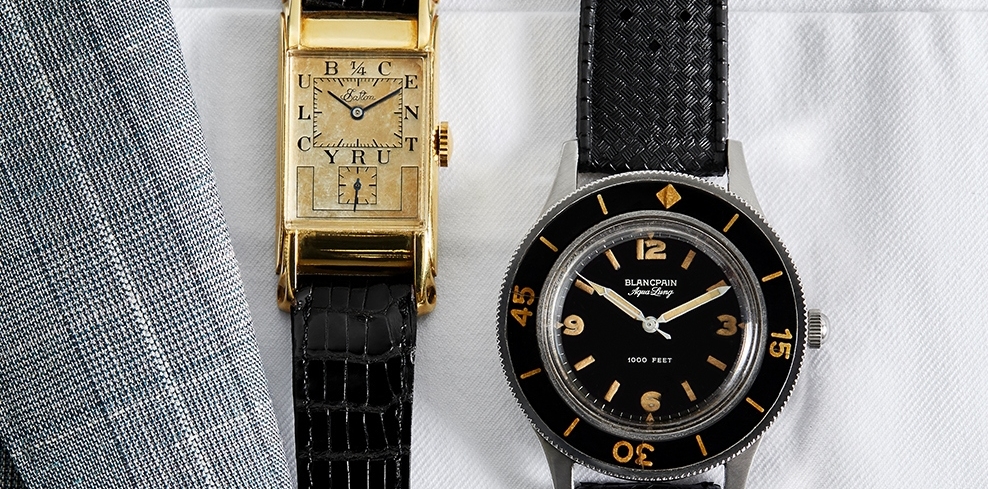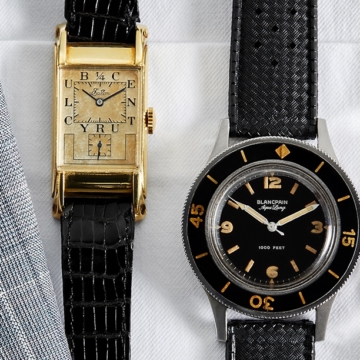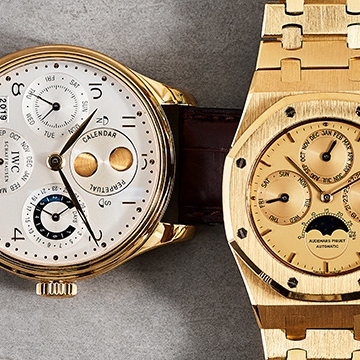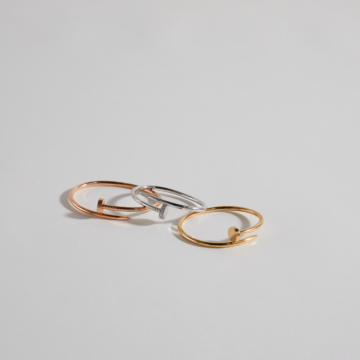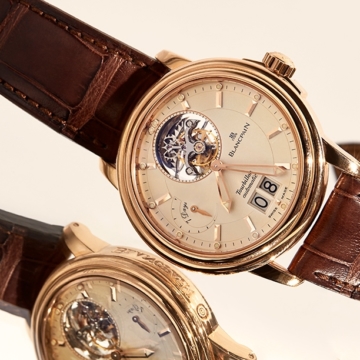“Honest” Vintage Watches: What’s Behind The Hype?
Words by Jody Hume |
8.30.19
These days, a vintage watch can have no better reputation than being “honest.” Honest watches are generally unrestored and unpolished timepieces that maintain their original factory-installed parts. While the allure of a brand new, fresh-from-the-box watch may appeal to many, collectors are fascinated with the stories that an oxidized bezel, a faded dial or a scratched crystal might reveal about an older timepiece’s past.
An example of a newsworthy almost-honest watch is Paul Newman’s actual 1968 “Paul Newman” Rolex Daytona—complete with scratched bezel, “Drive Carefully Me”-engraved caseback and most of its original parts—which fetched a record-breaking $17.8 million at auction. But what is the hype really about, and what’s it like to embrace an honest watch, flaws and all? Read on as Karin Dickinson, our resident Horologist, explains the appeal for collectors and uncovers the mysterious former lives of three vintage watches.
What is the appeal of “honest” watches for collectors?
An “honest” watch is one that tells a story, a watch that shows it’s been well-worn and well-loved. Collectors love to revel in the history of a watch, and the rule seems to be “the more beat up, the better,” since it so vividly illustrates a watch’s previous life. Older watches were also made with materials that didn’t withstand the test of time as well as modern materials, so a discolored radium or tritium dial on an early Rolex, for example, reassures you that you’re looking at a piece of history.
What kinds of imperfections now make certain watches more coveted?
Tropical dials, which have turned a dusty brown due to sun exposure, have become highly sought-after, as well as things like original crystals with scratches, flaking hands and ghost bezels. Ghost bezels are similar to tropical dials—they’ve faded due to a combination of sun exposure, abrasion and age. Some people even try to artificially manufacture this effect with bleach and other chemicals.
How do restorations affect the way horologists at TRR assess a watch?
We can generally pinpoint a production year or decade based on the materials used. If we see evidence of radium on a dial from a particular brand, for example, we know it probably dates back to at least the early 1960s, though it could be much older. Watches that have had different levels of restoration implemented can make this tricky, but that’s also why we do extensive research based on reference numbers, movement calibres, etc. That being said, if in the course of our research we find a discrepancy in materials or the calibre, we know that this is something that requires further verification.
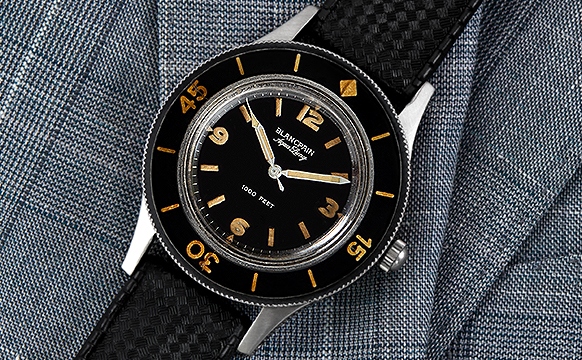
What’s the history behind this model?
In the early 1950s, the French Ministry of Defense was shopping around for a watch for their French Combat Swimmers unit, also known as the frogmen. When you dive, you need to take into account the amount of oxygen left in your tank and how long you’ve been underwater, and a wristwatch can account for that. The team connected with Blancpain’s CEO, Jean-Jacques Fiechter, who was a diver himself. Fiechter had already begun work on a timing instrument for his own underwater activities, and determined that the timepiece would need luminescent hands and contrasting hour-markers, a water-resistant and anti-magnetic case, a secured rotating bezel and a self-winding movement.
In 1953, Fiechter facilitated the creation and production of the first Aqua-Lung. These original models were capable of withstanding pressures up to 300 feet deep. By the end of the ‘50s, through further research and development, that depth was increased to 1,000 feet, like the model seen here.
What does the watch’s current condition reveal about its history?
This Blancpain is protected by a stainless steel case—great for saltwater diving, since it won’t rust—with an acrylic crystal, radium dial and Bakelite rotating bezel. It predates the use of synthetic sapphire crystals, so acrylic would have been the best choice at the time. For decades, radium was the go-to luminous material for watches and clocks around the world. Radium shows its age, and upon examination, I discovered that the hands were definitely repainted at some point. Therefore, not a 100% “honest” vintage watch. The metal was shiny and new, and the luminous paint was a distinctly different color from the paint on the dial. The hands also glowed green under UV light, which is characteristic of Luminova, a Japanese photoluminescent material developed in the early 1990s.
Like radium, the synthetic plastic Bakelite doesn’t stand the test of time well, which is partially why it’s no longer widely used for watches. Bakelite is prone to cracking and can discolor over time. It’s been replaced in the watch world by innovations like aluminum bezel inserts and ceramic inserts. Blancpain’s newest Fifty Fathoms models actually have synthetic sapphire bezel inserts. They’ve come a long way from using Bakelite, but coming across a watch that uses it is still a treat.
What are the tell-tale signs that a watch has been altered or restored?
It usually comes down to the details. When I looked at this watch’s dial under 10x magnification, I could see white paint peeking out from under the hour markers. I knew without using magnification that the hands had been repainted, but the white color of the hour markers made me think that at some point, probably when they were still using radium, the dial had been touched up.
It’s not surprising that a watch this old would have little fixes. A watch with the original hands would likely hold a higher value, but sometimes it becomes a choice between replacing the hands or having no hands at all, and the best solution is to replace them. It’s rare to see a watch like this with all of its original parts.
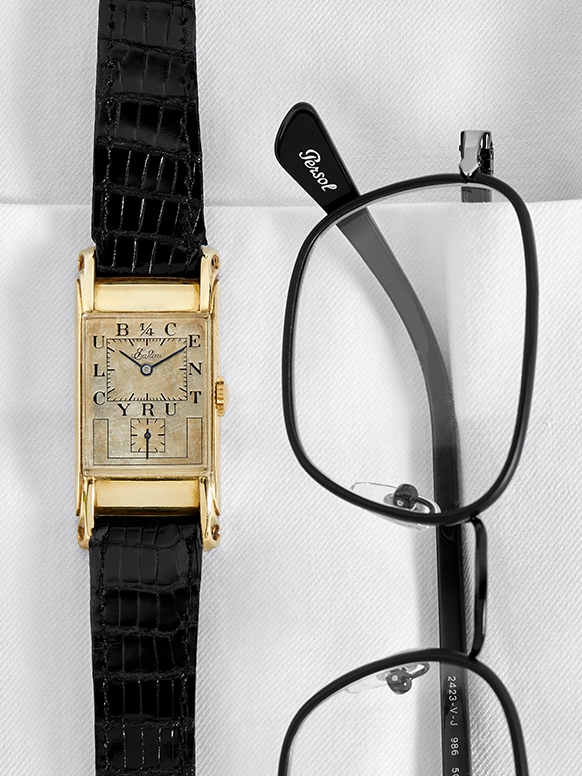
What’s the history behind this Rolex?
Based on the serial number, this piece dates back to 1950, though the model was certainly made both before and after 1950. It’s an excellent example of early Rolex manufacturing. Rolex produced this watch and many like it for the T. Eaton Company Limited, or Eaton’s. At one time it was Canada’s largest department store chain. Eaton’s would give these watches as a corporate gift to employees who had been with the company for 25 years (hence the Quarter Century Club title).
What can you tell us about this watch’s condition? Does it allude to anything about the previous wearer?
The discoloration on the dial and light discoloration on the case are typical for older watches like this. The manufacture date of this timepiece predates water and dust resistance, so this model does not have gaskets or glue seals to prevent moisture or dust from getting in. The end result is usually a faded dial, but this is still in remarkably good shape all things considered. It’s clear that the previous owner took good care of this watch.
This model is engraved “Presented to Donald M. Bird to mark a quarter century of continuous service with the T. Eaton c limited 1926- 1951.” I think personal touches like this are fascinating, because they add a narrative to the watch. One could wonder, what did Mr. Bird do for Eaton’s? Did he work in the shipping department packing boxes full of home appliances? Was he a catalogue designer (a huge part of Eaton’s business was based in mail orders)? Did he sit in boardrooms and help expand the business across Canada and into Europe? Personal engravings have a way of igniting the imagination, while also giving some historical background.
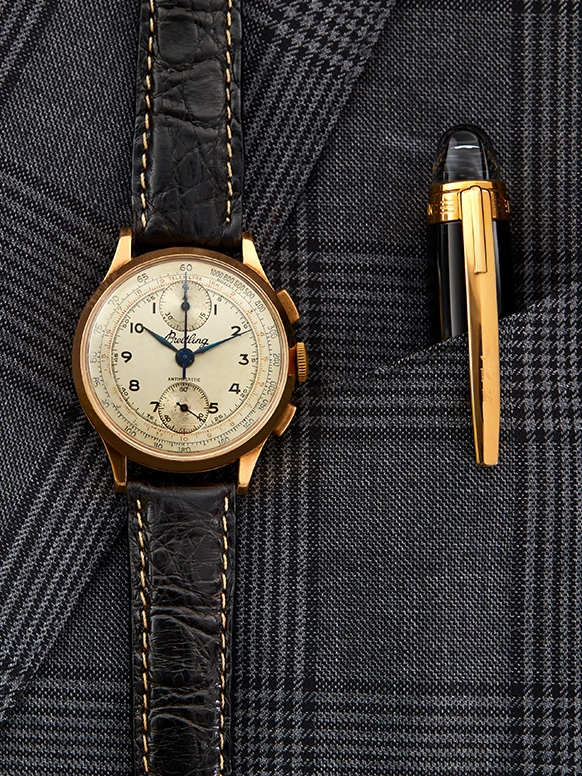
What is this vintage watch’s story, and how does its condition shed light on its former life?
This is such an interesting piece! The company was founded in 1884 by Léon Breitling, who mainly focused on chronographs because there was a high demand for time measurement in military, industrial and scientific applications. His son took over after his death in 1914, and eventually Breitling’s grandson took over after him.
This particular watch dates back to the 1940s. It’s a typical example of one of their older chronograph watches and slightly resembles the Breitling Chronomat. It may be one of the last models released before the introduction of their now-iconic Navitimer pilot watch. You can definitely see hints of the Navitimer’s style in this.
When inspecting this watch, the first things that jumped out at me were the dial and the beat-up crystal. The dial is in great condition despite the watch’s age, though it looks like there is a little bit of moisture damage. This isn’t uncommon for an older watch, but in general I’d say the previous owner loved this watch enough to take relatively good care of it.
The back of this watch is engraved “Johs Hartmann / Konigl Hof Uhrmache / U.d Linden 48-49 / Berlin.” What does this tell us about the watch’s history?
To be honest (no pun intended), this timepiece is a little bit of a mystery. Found on the caseback is the address of German clockmaker Johannes Hartmann’s workshop. Johs is often short for Johannes, so perhaps this watch was used as a commemorative piece celebrating his work. Hartmann was active from 1856-1872, so it’s unlikely he had any ties to Swiss-based Breitling, which was founded in 1884. But as an elegant watch, this could have been used in some way to celebrate Hartmann.
